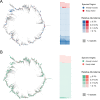PhyloPlus: a Universal Tool for Phylogenetic Interrogation of Metagenomic Communities
- PMID: 36645293
- PMCID: PMC9973285
- DOI: 10.1128/mbio.03455-22
PhyloPlus: a Universal Tool for Phylogenetic Interrogation of Metagenomic Communities
Abstract
Phylogeny is a powerful tool that can be incorporated into quantitative descriptions of community diversity, yet its use has been limited largely due to the difficulty in constructing phylogenies which incorporate the wide genomic diversity of microbial communities. Here, we describe the development of a web portal, PhyloPlus, which enables users to generate customized phylogenies that may be applied to any bacterial or archaeal communities. We demonstrate the power of phylogeny by comparing metrics that employ phylogeny with those that do not when applied to data sets from two metagenomic studies (fermented food, n = 58; human microbiome, n = 60). This example shows how inclusion of all bacterial species identified by taxonomic classifiers (Kraken2 and Kaiju) made the phylogeny perfectly congruent to the corresponding classification outputs. Our phylogeny-based approach also enabled the construction of more constrained null models which (i) shed light into community structure and (ii) minimize potential inflation of type I errors. Construction of such null models allowed for the observation of under-dispersion in 44 (75.86%) food samples, with the metacommunity defined as bacteria that were found in different food matrices. We also observed that closely related species with high abundance and uneven distribution across different sites could potentially exaggerate the dissimilarity between phylogenetically similar communities if they were measured using traditional species-based metrics (Padj. = 0.003), whereas this effect was mitigated by incorporating phylogeny (Padj. = 1). In summary, our tool can provide additional insights into microbial communities of interest and facilitate the use of phylogeny-based approaches in metagenomic analyses. IMPORTANCE There has been an explosion of interest in how microbial diversity affects human health, food safety, and environmental functions among many other processes. Accurately measuring the diversity and structure of those communities is central to understanding their effects. Here, we describe the development of a freely available online tool, PhyloPlus, which allows users to generate custom phylogenies that may be applied to any data set, thereby removing a major obstacle to the application of phylogeny to metagenomic data analysis. We demonstrate that the genetic relatedness of the organisms within those communities is a critical feature of their overall diversity, and that using a phylogeny which captures and quantifies this diversity allows for much more accurate descriptions while preventing misleading conclusions based on estimates that ignore evolutionary relationships.
Keywords: diversity; metagenomics; microbial genomics; microbiome; phylogeny.
Conflict of interest statement
The authors declare no conflict of interest.
Figures






References
-
- Caputo M, Zoch-Lesniak B, Karch A, Vital M, Meyer F, Klawonn F, Baillot A, Pieper DH, Mikolajczyk RT. 2019. Bacterial community structure and effects of picornavirus infection on the anterior nares microbiome in early childhood. BMC Microbiol 19:1. doi:10.1186/s12866-018-1372-8. - DOI - PMC - PubMed
-
- Mostafa HH, Fissel JA, Fanelli B, Bergman Y, Gniazdowski V, Dadlani M, Carroll KC, Colwell RR, Simner PJ. 2020. Metagenomic next-generation sequencing of nasopharyngeal specimens collected from confirmed and suspect COVID-19 patients. mBio 11:e01969-20. doi:10.1128/mBio.01969-20. - DOI - PMC - PubMed
Publication types
MeSH terms
Substances
Grants and funding
LinkOut - more resources
Full Text Sources
